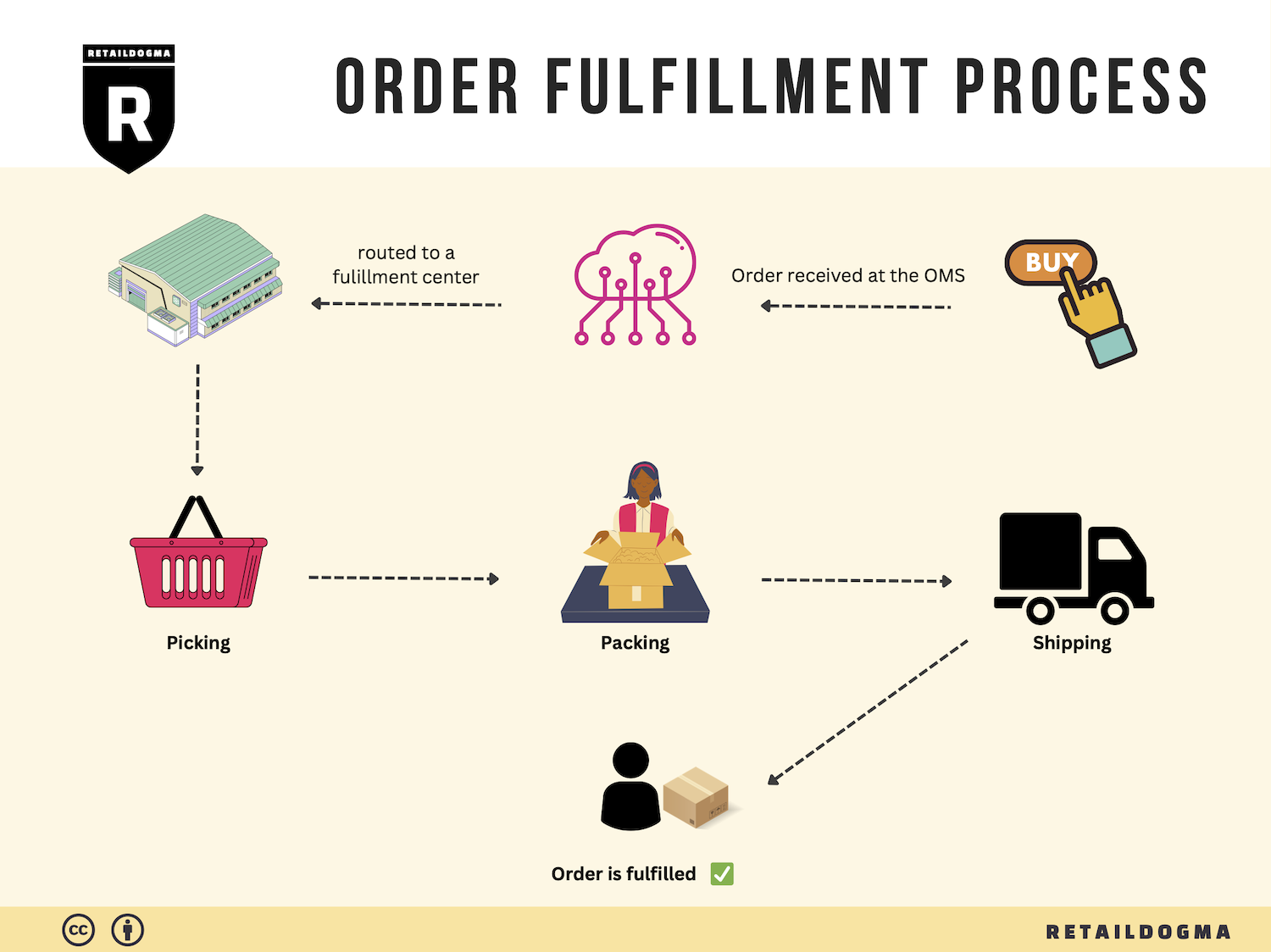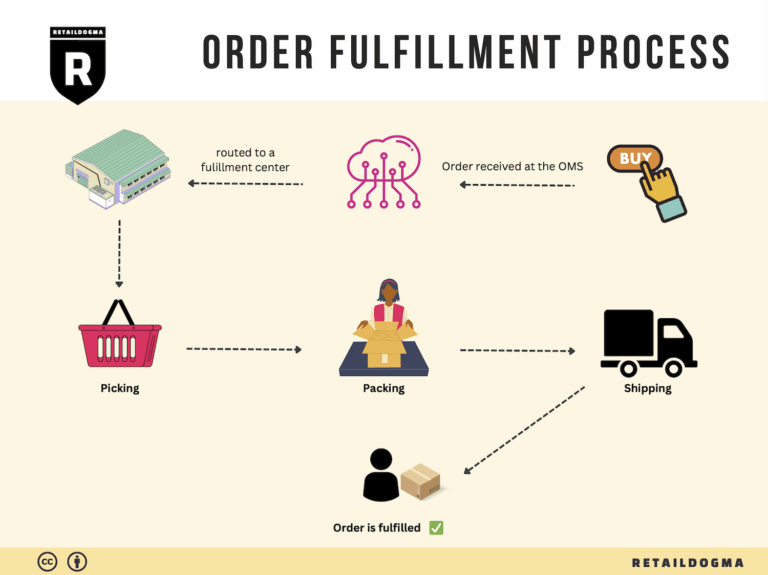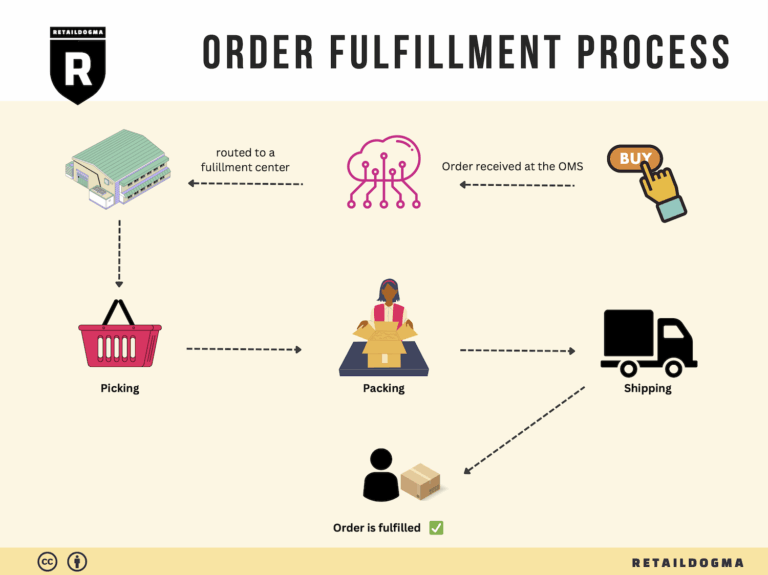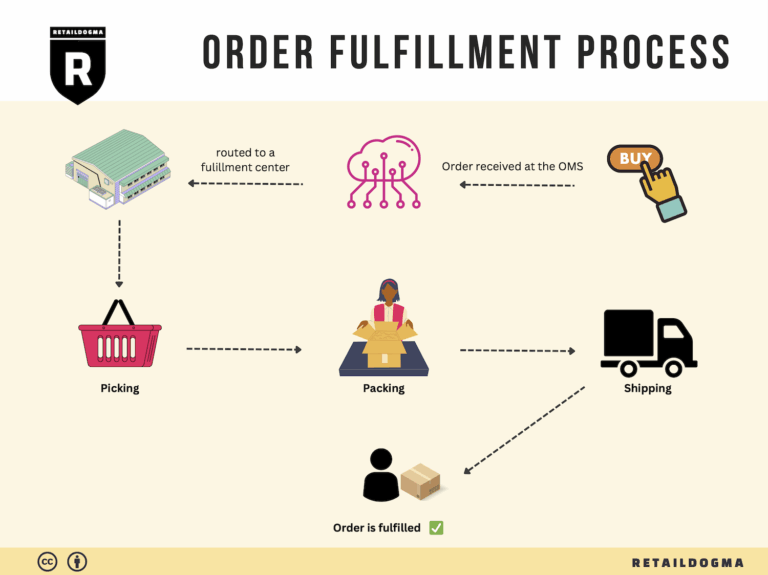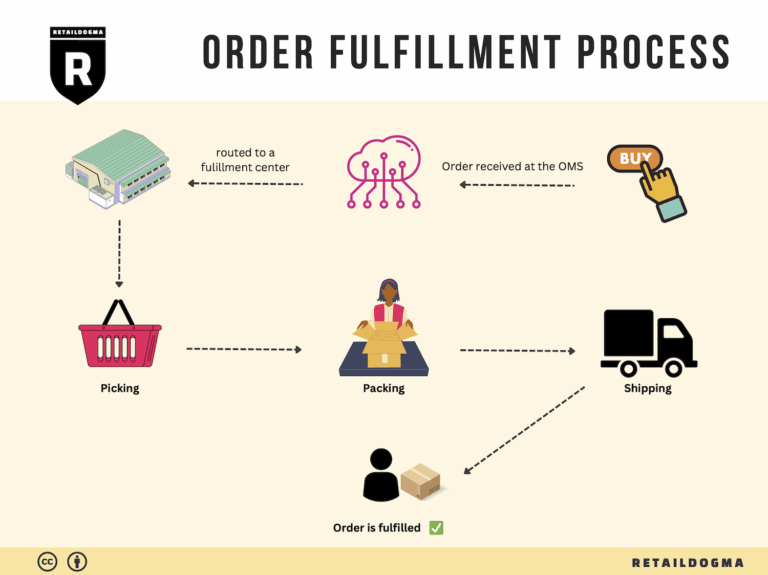What Is A Fulfillment Center? A Complete Guide (2025)
What is E-commerce Fulfillment? An Introduction for Growing Businesses
Understanding the Fulfillment Challenge
For many growing e-commerce businesses, the excitement of increased sales can quickly turn into a daunting challenge as packing and shipping orders become overwhelming. As your customer base expands, the logistical complexities of order fulfillment can threaten to stifle your growth. This is where a robust e-commerce fulfillment strategy becomes essential.
At its core, e-commerce fulfillment is the process of getting a product from your warehouse or fulfillment center to your customer’s doorstep. It encompasses a series of critical steps: receiving inventory, storing products, processing orders, picking and packing items, shipping, and handling returns. Each of these components requires meticulous attention to detail to ensure customer satisfaction and operational efficiency.
What This Guide Covers
In this guide, we will delve into various fulfillment models that can help you streamline your logistics and scale your operations effectively. We’ll explore:
-
Fulfillment Models: Understanding the differences between in-house fulfillment, dropshipping, third-party logistics (3PL), and hybrid models will empower you to choose the best approach for your business needs.
-
Core Services: We’ll break down essential fulfillment services, including inventory management, order processing, shipping logistics, and returns handling, so you can identify which services align with your operational goals.
-
Choosing a Partner: Selecting the right fulfillment partner is crucial. We’ll provide insights on what to look for in a fulfillment provider, including technology capabilities, customer service, and scalability options.
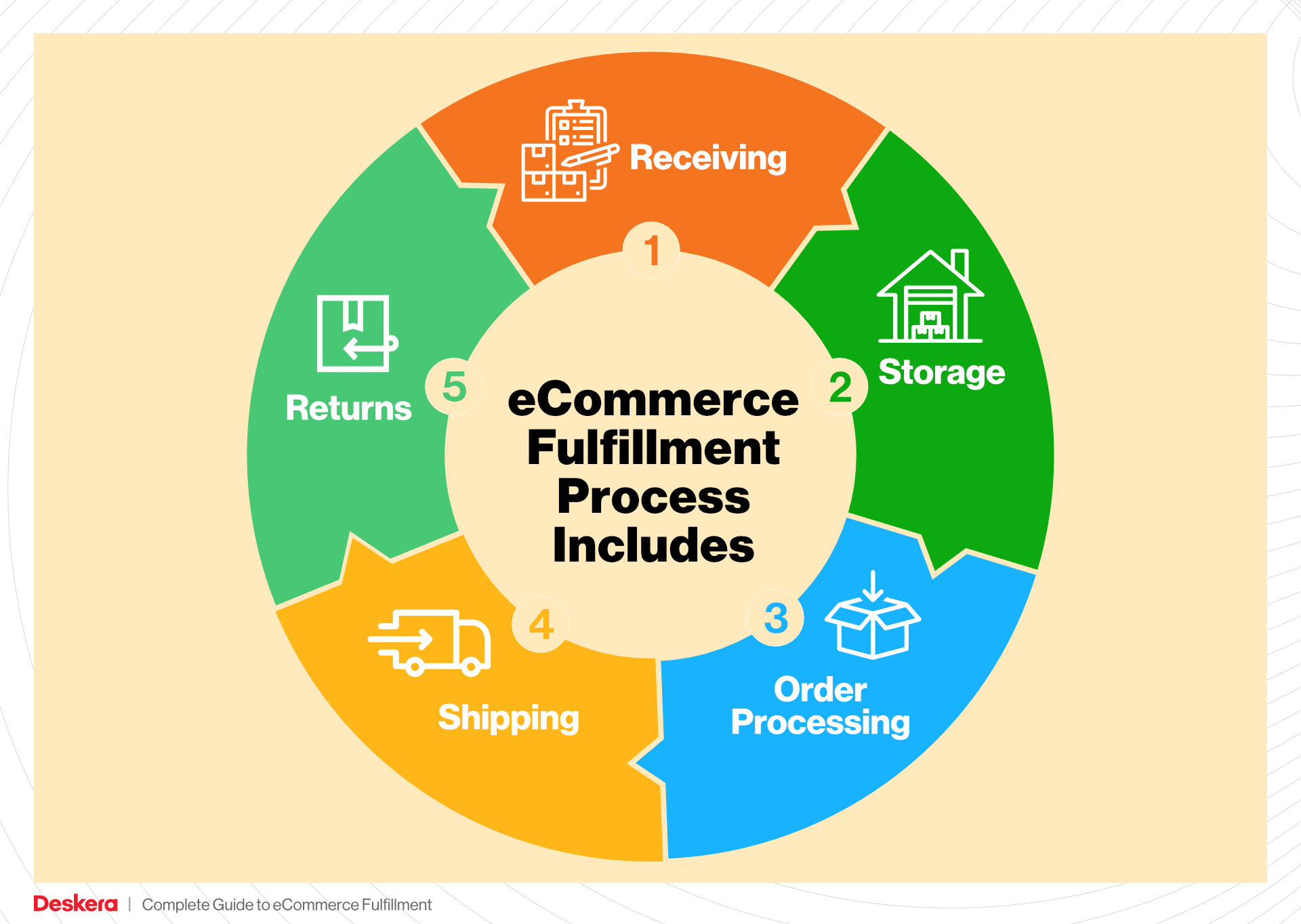
-
Pricing Structures: Understanding the cost implications of different fulfillment options is key to maintaining profitability. We’ll outline common pricing models and factors that influence costs, helping you make informed financial decisions.
Guiding Your Logistics Decisions
The goal of this guide is to equip e-commerce business owners, operations managers, and entrepreneurs with the knowledge to make informed decisions about their fulfillment strategies. By understanding the intricacies of e-commerce fulfillment and exploring the various options available, you will be better positioned to optimize your logistics, enhance customer satisfaction, and ultimately drive growth in your business.
Join us as we navigate the world of e-commerce fulfillment, transforming potential pain points into streamlined processes that empower your business to thrive.
What You’ll Learn In This Guide
- What is E-commerce Fulfillment? An Introduction for Growing Businesses
- The Order Fulfillment Process: From ‘Buy’ Button to Customer’s Door
- Comparing Fulfillment Models: In-House vs. 3PL vs. Dropshipping
- A Deep Dive into Amazon FBA: Pros, Cons, and Who It’s For
- Core Services Offered by Fulfillment Centers
- How to Choose a Fulfillment Partner: A 6-Point Checklist
- Understanding Fulfillment Pricing: A Breakdown of Common Fees
- Frequently Asked Questions (FAQs) about Fulfillment
- Conclusion: Is Outsourcing Fulfillment the Right Move for Your Business?
- Important Disclaimer
The Order Fulfillment Process: From ‘Buy’ Button to Customer’s Door
1. Receiving Inventory
The order fulfillment process begins with receiving inventory. When products arrive from suppliers or manufacturers, they are unloaded at the warehouse or fulfillment center. This step involves counting the items, checking for quality, and verifying that the received products match the purchase order. Key to this process is the use of SKU (Stock Keeping Unit), a unique identifier for each product that simplifies tracking and inventory management.
Why is this step important? Proper receiving is crucial for maintaining accurate inventory levels. Any discrepancies can lead to stockouts or overstock situations, both of which can negatively impact sales and customer satisfaction. By ensuring that the inventory is received accurately, businesses can maintain a smooth flow in the subsequent steps of the fulfillment process.
2. Warehouse Storage
Once inventory has been received and verified, the next step is warehouse storage. This involves organizing products in a way that optimizes accessibility and minimizes retrieval time. Effective storage strategies can include using ABC analysis to categorize inventory based on demand, where “A” items are high-demand products, “B” items are moderate, and “C” items are low-demand.
This step is vital because a well-organized warehouse can significantly enhance the efficiency of order fulfillment. By strategically placing high-turnover items closer to the packing area, businesses can reduce the time it takes to pick orders. Additionally, employing advanced inventory management systems can help track stock levels and locations, ensuring that inventory is always available when needed.
3. Order Picking
The next step in the fulfillment process is order picking. When a customer places an order, the details are sent to the warehouse management system, which generates a pick list. This list indicates the items to be retrieved from the storage area, often organized by location to streamline the picking process.
Why is order picking critical? This step directly impacts the speed of fulfillment and, ultimately, customer satisfaction. Faster and more accurate picking leads to quicker order processing and shipment. Employing technology such as barcode scanners or pick-to-light systems can enhance accuracy and efficiency, reducing errors that could lead to returns or customer dissatisfaction.
4. Order Packing
Once items have been picked, the next step is order packing. This involves carefully packaging the products to ensure they arrive at the customer’s doorstep in perfect condition. Packaging materials can range from boxes to eco-friendly wrapping, depending on the product and brand image. Additionally, creating a packing slip that includes order details helps in verifying that the correct items are included before shipping.
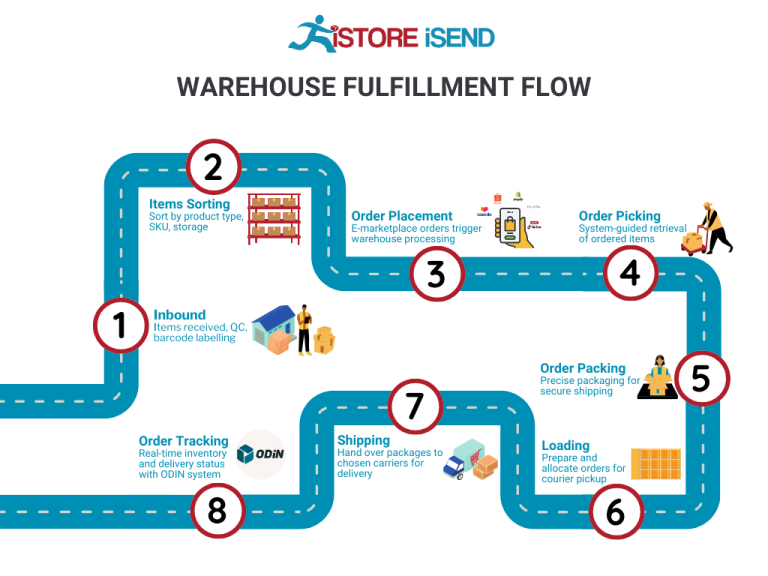
The importance of packing cannot be overstated. Proper packing protects products during transit and can also enhance the customer experience. Thoughtful packaging can reinforce brand identity and encourage repeat purchases. Furthermore, ensuring that packages are appropriately labeled with shipping information and tracking details is essential for smooth delivery.
5. Shipping & Delivery
The final step in the fulfillment process is shipping and delivery. Once the order is packed, it is handed over to a shipping carrier for transport to the customer. This may involve multiple modes of transportation, such as ground, air, or sea, depending on the destination and delivery speed required. Utilizing a shipping management system can help businesses optimize carrier selection and manage shipping costs effectively.
This step is crucial for customer satisfaction. Timely delivery is often a key factor in customer loyalty, and efficient shipping processes can help meet or exceed customer expectations. By offering various shipping options and tracking capabilities, businesses can enhance the overall customer experience, ensuring that orders arrive on time and in good condition.
In summary, each step of the order fulfillment process—from receiving inventory to shipping and delivery—plays a vital role in ensuring that e-commerce businesses operate efficiently and effectively. By optimizing these steps, businesses can scale operations, improve customer satisfaction, and ultimately drive growth.
Comparing Fulfillment Models: In-House vs. 3PL vs. Dropshipping
Fulfillment Models Overview
E-commerce businesses have various fulfillment models to choose from, each with its unique advantages and disadvantages. Selecting the right model is crucial for scaling operations, managing costs, and ensuring customer satisfaction. Below is a comparison of the three primary fulfillment models: In-House Fulfillment, Third-Party Logistics (3PL), and Dropshipping.
| Model | Who Handles Inventory | Best For (Business Stage) | Key Advantage | Key Disadvantage |
|---|---|---|---|---|
| In-House Fulfillment | The business itself | Startups and small businesses | Full control over inventory and processes | High overhead costs and resource demands |
| Third-Party Logistics (3PL) | A specialized logistics provider | Growing businesses and scaling brands | Scalability and expertise in logistics | Less control over inventory and processes |
| Dropshipping | The supplier | New businesses and low-capital ventures | Low upfront investment and risk | Lower profit margins and potential delays |
In-House Fulfillment
In-house fulfillment refers to the process where a business manages its own inventory, order processing, and shipping operations. This model is often favored by startups and small businesses that want to maintain complete control over their products and customer experience. By handling fulfillment in-house, businesses can ensure that their branding and quality standards are upheld at every step of the order process.
However, while in-house fulfillment allows for greater control, it also comes with significant overhead costs. Businesses must invest in warehousing, staffing, and technology to manage operations effectively. As order volume increases, the complexity of managing logistics can overwhelm small teams, leading to inefficiencies and potential errors. Additionally, scaling an in-house operation can be challenging, as it often requires significant investment in infrastructure and human resources.
Third-Party Logistics (3PL)
Third-party logistics (3PL) involves outsourcing the storage, fulfillment, and shipping processes to a specialized logistics provider. This model is particularly advantageous for growing businesses that need to scale quickly without the burden of managing logistics in-house. 3PL providers offer a range of services, from inventory management to shipping, allowing businesses to focus on core activities like marketing and product development.
The key advantage of using a 3PL is scalability. As order volumes fluctuate, businesses can easily adjust their logistics needs without the need for substantial investments in infrastructure. Additionally, 3PL providers often have established relationships with shipping carriers, which can lead to cost savings and faster delivery times. However, outsourcing fulfillment means that businesses relinquish some control over their inventory and processes, which can lead to challenges in maintaining brand standards and customer service levels.
Dropshipping
Dropshipping is a fulfillment model where the retailer does not hold inventory but instead transfers customer orders directly to a supplier or manufacturer, who then ships the products to the customer. This model is particularly appealing for new businesses and entrepreneurs with limited capital, as it eliminates the need for upfront inventory investment.
The primary advantage of dropshipping is the low barrier to entry. Retailers can offer a wide range of products without the risks associated with holding inventory. This model also allows for flexibility in product offerings, as businesses can quickly test and pivot to new products based on market demand. However, dropshipping typically comes with lower profit margins, as suppliers often charge a premium for handling logistics. Additionally, retailers may face challenges with order fulfillment times and quality control, as they rely on third parties for product availability and shipping.
Conclusion
Selecting the right fulfillment model is a critical decision for e-commerce businesses looking to scale. In-house fulfillment offers control but can be resource-intensive. 3PL provides scalability and expertise but at the cost of some control. Dropshipping presents a low-risk entry point but may lead to lower profit margins and potential fulfillment issues. Understanding these models allows business owners to make informed decisions that align with their growth strategies and operational capabilities.
A Deep Dive into Amazon FBA: Pros, Cons, and Who It’s For
Understanding Fulfillment by Amazon (FBA)
Fulfillment by Amazon (FBA) is a service provided by Amazon that allows sellers to store their products in Amazon’s fulfillment centers. Amazon takes care of storage, packaging, shipping, and customer service for these products. This model enables sellers to leverage Amazon’s vast logistics network and customer base, providing a significant advantage in the e-commerce marketplace.
When a customer places an order for a product fulfilled by Amazon, the item is picked from the seller’s inventory stored in an Amazon warehouse, packed, and shipped directly to the customer. Moreover, Amazon handles all customer inquiries and returns, allowing sellers to focus on other aspects of their business.
How FBA Works
- Sign Up for FBA: Sellers create an Amazon seller account and enroll in the FBA program.
- Inventory Preparation: Products must be prepared according to Amazon’s guidelines, which include labeling and packaging requirements.
- Shipping Inventory to Amazon: Sellers send their inventory to Amazon’s fulfillment centers. Amazon provides shipping labels and instructions to facilitate this process.
- Storage: Once the inventory arrives at Amazon’s warehouse, it is stored until sold.
- Order Processing: When a customer orders a product, Amazon picks the item from the warehouse, packs it, and ships it.
- Customer Service: Amazon manages customer service and returns for FBA products, providing a seamless experience for both sellers and customers.
Pros of Using FBA
Prime Eligibility
One of the most significant advantages of FBA is that products become eligible for Amazon Prime. This can lead to increased visibility and sales, as Prime members often prefer products with free two-day shipping. By tapping into this customer base, sellers can enhance their sales potential significantly.
Customer Trust
Amazon is a trusted brand with millions of loyal customers. By using FBA, sellers can benefit from this trust. Customers often feel more confident purchasing products that are fulfilled by Amazon, knowing they will receive reliable service and support. This trust can lead to higher conversion rates and customer retention.
Multi-Channel Fulfillment
FBA isn’t limited to just Amazon.com. Sellers can utilize FBA to fulfill orders from other sales channels, such as their own websites or other online marketplaces. This flexibility allows for streamlined operations and inventory management, as sellers can rely on Amazon’s logistics for all their sales channels.
Scalability
FBA provides a scalable solution for growing businesses. Sellers can easily increase their inventory without worrying about warehousing space or logistics. As order volumes rise, Amazon’s fulfillment network can handle the increased demand, allowing sellers to focus on expanding their product offerings.
Cons of Using FBA
High Fees
While FBA offers many benefits, it comes at a cost. Amazon charges various fees, including storage fees for inventory stored in their warehouses and fulfillment fees for each order shipped. These costs can quickly add up, eating into profit margins, especially for lower-priced items.
Strict Inventory Rules
Sellers must adhere to Amazon’s strict inventory management policies. This includes guidelines on inventory limits, product condition, and packaging standards. Failure to comply can result in additional fees or even account suspension, which can be detrimental to a seller’s business.
Commingling Risks
FBA uses a system of commingling inventory, where products from different sellers are stored together. This can lead to complications if a customer receives a product that doesn’t meet their expectations or is defective. In such cases, it can be challenging for sellers to manage returns and ensure their brand reputation remains intact.
Limited Control
Using FBA means relinquishing some control over the fulfillment process. Sellers must trust Amazon to handle their inventory and customer service. While Amazon generally provides excellent service, any issues that arise can reflect poorly on the seller, leading to negative reviews and potential loss of customers.
Who is FBA Best For?
Fulfillment by Amazon is particularly beneficial for:
- Small to Medium-Sized Businesses: Businesses looking to scale quickly without investing heavily in logistics can benefit from FBA’s infrastructure.
- E-commerce Entrepreneurs: Those just starting in e-commerce can leverage FBA to manage logistics and customer service, allowing them to focus on marketing and product development.
- Sellers with High Sales Volume: Businesses that sell high volumes of products can take advantage of FBA’s efficiency and potentially lower shipping costs.
- Brands Seeking Prime Access: Companies aiming to reach Amazon’s Prime members and tap into the trust associated with Amazon’s brand will find FBA advantageous.
In conclusion, while Fulfillment by Amazon offers numerous benefits, such as access to Prime members and streamlined logistics, it is essential for sellers to weigh these against the potential downsides, including high fees and loss of control over the fulfillment process. Careful consideration of business needs and growth plans will determine whether FBA is the right fit for any specific e-commerce venture.
Core Services Offered by Fulfillment Centers
Inventory Management & Warehousing
Effective inventory management is a cornerstone of successful e-commerce operations. Fulfillment centers provide comprehensive inventory management services that include receiving, storing, and tracking products within their warehouses. Upon arrival, products undergo quality checks and are logged into an inventory management system, ensuring that all items are accounted for and organized efficiently.
The benefits of robust inventory management are multifold:
-
Reduced Costs: By outsourcing warehousing, businesses can save on overhead costs associated with maintaining their own storage facilities. Fulfillment centers typically have established infrastructure and systems to manage inventory more efficiently.
-
Optimized Space Utilization: Fulfillment centers are designed to maximize storage capacity, allowing businesses to scale their inventory without the need for larger physical spaces. This is especially beneficial for seasonal or fluctuating demand.
-
Real-Time Tracking: With integrated inventory management systems, businesses gain access to real-time data regarding stock levels, helping them make informed purchasing and sales decisions. This minimizes the risk of stockouts or overstock situations.
-
Scalability: As businesses grow, their inventory needs can change rapidly. Fulfillment centers can easily accommodate these changes, providing flexible storage solutions that align with the e-commerce business’s growth trajectory.
Pick and Pack Services
Once an order is placed, the next critical step in the fulfillment process is picking and packing. Fulfillment centers excel in efficiently retrieving products from inventory and preparing them for shipment. This process involves accurately selecting items based on customer orders and packaging them securely for transport.
The advantages of professional pick and pack services include:
-
Speed and Accuracy: Fulfillment centers employ trained staff and advanced technology to ensure orders are picked accurately and dispatched quickly. This level of efficiency leads to faster shipping times, which can significantly enhance customer satisfaction.
-
Error Reduction: Automated systems and trained personnel minimize the likelihood of errors in order fulfillment, reducing costly returns and improving overall operational efficiency.
-
Customized Packaging: Many fulfillment centers offer tailored packaging solutions that align with the brand’s identity and customer preferences. This not only enhances the unboxing experience but also helps in reducing shipping costs through optimized package sizes.
-
Order Volume Flexibility: During peak seasons, such as holidays or promotional events, fulfillment centers can quickly scale their operations to handle increased order volumes, ensuring that customer demands are met without delays.
Kitting and Assembly
Kitting and assembly services provided by fulfillment centers allow e-commerce businesses to streamline the process of combining multiple products into a single package or kit. This service is particularly beneficial for businesses that offer bundles, promotional packages, or complex products requiring assembly before shipping.
The benefits of kitting and assembly services include:
-
Simplified Logistics: By combining multiple items into a single package, businesses can reduce the complexity of their logistics operations. This simplifies inventory management and reduces the time spent on order fulfillment.
-
Enhanced Customer Experience: Well-assembled kits can create a more appealing product offering, encouraging higher average order values and customer satisfaction. This approach also provides customers with a cohesive solution rather than multiple separate products.
-
Cost-Effectiveness: Kitting can lead to reduced shipping costs by optimizing the number of packages sent out, as well as minimizing packaging materials used. This not only saves money but also contributes to sustainability efforts.
-
Branding Opportunities: Custom kitting allows businesses to present their products in a way that aligns with their brand image. Thoughtful assembly can enhance the perceived value of the product, making it more attractive to customers.
Returns Management (Reverse Logistics)
Returns management, or reverse logistics, is a critical aspect of e-commerce fulfillment that is often overlooked. Fulfillment centers provide streamlined processes for handling returns, ensuring that they are processed efficiently and effectively.
The key benefits of robust returns management services are:
-
Customer Satisfaction: A hassle-free return process can significantly enhance customer loyalty. Fulfillment centers can facilitate easy returns, making it more likely that customers will shop again, even if they had to return a product.
-
Inventory Control: Efficient returns management allows businesses to quickly restock returned items and update inventory levels. This reduces downtime and ensures that products are available for resale as soon as possible.
-
Data Insights: Fulfillment centers can provide valuable insights into return reasons and patterns, helping businesses identify potential issues with their products. This data can inform product development and marketing strategies.
-
Cost Management: By outsourcing returns management, businesses can save time and resources. Fulfillment centers have established processes to handle returns efficiently, reducing the workload on internal teams and allowing them to focus on growth and customer engagement.
In conclusion, partnering with a fulfillment center can provide e-commerce businesses with essential services that enhance efficiency, scalability, and customer satisfaction. By leveraging these core services, businesses can focus on strategic growth while ensuring that their logistics operations run smoothly.
How to Choose a Fulfillment Partner: A 6-Point Checklist
Location & Warehouse Network
Importance:
The geographical location of your fulfillment partner and the distribution of their warehouse network play a crucial role in shipping efficiency and costs. A partner with strategically located warehouses can reduce transit times and shipping expenses, improving your overall customer satisfaction.
Questions to Ask:
1. Where are your warehouses located, and how do they align with my target customer demographics?
2. What is the average shipping time to key regions?
3. Do you have multiple warehouse locations to facilitate faster deliveries?
4. How do you handle inventory across different locations, and what systems do you have in place for managing stock levels?
Technology & Integrations
Importance:
In today’s e-commerce landscape, technology is the backbone of efficient fulfillment. A partner with robust technology solutions can seamlessly integrate with your existing systems, providing real-time data and analytics that help you make informed business decisions.
Questions to Ask:
1. What order management system (OMS) do you use, and how does it integrate with my e-commerce platform?
2. Can you provide a demo of your technology, including inventory tracking, order processing, and reporting features?
3. How do you handle updates or changes in technology? Is there an in-house IT team to support this?
4. What kind of reporting and analytics do you provide, and how can I access this data?
Specializations (e.g., Cold Storage, Oversized Items)
Importance:
Depending on your product range, you may require specific services that cater to unique storage and shipping needs, such as temperature control for perishables or handling oversized items. Choosing a partner with the right specializations ensures your products are handled correctly.
Questions to Ask:
1. What types of specialized fulfillment services do you offer (e.g., cold storage, fragile items, hazardous materials)?
2. Can you provide examples of how you have successfully managed specialized orders for other clients?
3. What processes do you have in place for quality control and compliance in handling specialized items?
4. How do you manage inventory for specialized products to ensure freshness and minimize waste?
Scalability & Capacity
Importance:
As your business grows, your fulfillment needs will evolve. A partner that can scale with you will save you time and resources in the long run. Understanding their capacity to handle increased volume is essential to avoid disruptions in service.
Questions to Ask:
1. How do you handle peak seasons or sudden spikes in order volume?
2. What is your current capacity, and how flexible are you in accommodating growth?
3. Can you provide references from clients who have scaled their operations with your help?
4. What measures do you take to ensure efficiency and speed during high-demand periods?
Pricing and Contracts
Importance:
Understanding the pricing structure and contract terms is critical to ensure that you are making a financially sound decision. Transparency in billing will help avoid hidden fees and provide a clear picture of your fulfillment costs.
Questions to Ask:
1. Can you provide a detailed breakdown of your pricing model (e.g., picking, packing, shipping, storage fees)?
2. Are there any hidden fees I should be aware of?
3. What are the contract terms, and is there flexibility in case my needs change?
4. How often do you review pricing, and what factors could lead to changes in fees?
Customer Support & Reviews
Importance:
Reliable customer support can make or break your fulfillment experience. You need a partner that is responsive and proactive in addressing issues as they arise. Additionally, reviews from other businesses can provide insight into their reliability and service quality.
Questions to Ask:
1. What level of support can I expect from your team? Is there a dedicated account manager?
2. How do you handle issues or disputes that may arise during the fulfillment process?
3. Can you provide references or testimonials from current or past clients?
4. How do you gather and implement feedback from your clients to improve your services?
By carefully evaluating potential fulfillment partners using this checklist, you can ensure that you choose a 3PL provider that not only meets your current needs but also supports your business as it scales. This strategic decision will enhance your operational efficiency, reduce costs, and ultimately improve customer satisfaction.
Understanding Fulfillment Pricing: A Breakdown of Common Fees
Initial Setup Fees
When partnering with a fulfillment center, the initial setup fees are often the first charges you’ll encounter. These fees can cover various aspects, including the onboarding process, integration of your inventory management systems, and the setup of customized packaging or kitting services.
Typically, initial setup fees are calculated based on the complexity of your integration needs and the volume of products you plan to manage. For example, a business with a straightforward product line may incur lower fees than one requiring extensive customization or software development. It’s essential to discuss your specific requirements with the fulfillment provider to ensure you understand what is included in these fees.
Receiving Fees
Receiving fees are charged when your products arrive at the fulfillment center. These fees cover the labor and resources involved in unloading, inspecting, counting, and storing your inventory.
The calculation of receiving fees can vary significantly based on several factors, including the volume of products, the size and weight of individual items, and the complexity of the receiving process (e.g., if items need to be checked for quality or sorted). Some fulfillment centers may charge a flat fee per pallet or box received, while others might bill based on the hourly rate of labor used during the receiving process. Understanding these fees upfront can help you budget more accurately.
Storage Fees (per pallet/bin)
Storage fees are incurred for keeping your inventory in the fulfillment center. These fees can be charged on a per-pallet or per-bin basis, depending on the layout and capacity of the facility.
The calculation of storage fees is influenced by the amount of space your products occupy and the duration they remain in the warehouse. Some providers may offer tiered pricing, where the cost per pallet decreases as you store more pallets. Additionally, if your products are seasonal or have fluctuating demand, it’s crucial to discuss how storage fees might change during peak times. This can help you manage your inventory more effectively and avoid unexpected costs.
Pick & Pack Fees (per item/order)
Pick and pack fees are one of the most common costs associated with order fulfillment. These fees cover the labor involved in selecting items from storage and packaging them for shipment.
Typically, pick and pack fees are calculated on a per-item or per-order basis. For instance, if an order contains multiple items, the fulfillment center may charge a fee for each item picked, in addition to a base fee for packing the order. The complexity of the packaging can also affect the cost; custom packaging or kitting services may incur additional charges. Businesses should assess their order profiles to estimate these fees accurately, as frequent small orders may lead to higher cumulative costs compared to larger, consolidated orders.
Shipping Fees
Shipping fees encompass the costs of transporting your orders to customers. These fees can vary widely based on the shipping method (e.g., standard, expedited), the weight and dimensions of the package, and the destination.
Fulfillment centers often offer discounted shipping rates through partnerships with major carriers, which can significantly reduce your costs. Shipping fees are typically calculated based on the dimensional weight of the package, which takes into account both its size and weight. It’s vital to understand how these fees are structured, as they can be a significant portion of your overall fulfillment costs. Additionally, inquire about any potential surcharges for specific destinations or delivery times to get a comprehensive view of your shipping expenses.
Tips for Getting an Accurate Quote
-
Provide Detailed Information: When requesting a quote, be as specific as possible about your product types, order volumes, and any special requirements (e.g., custom packaging). This will help the fulfillment center give you a more accurate estimate.
-
Ask About Hidden Fees: Ensure you understand all potential fees associated with fulfillment. Inquire about any additional charges that may arise, such as for returns management or seasonal storage.
-
Consider Your Growth Potential: Discuss your business growth projections with the fulfillment provider. Many companies offer scalable solutions, which can help you avoid overpaying during slower periods while accommodating increased demand during peak times.
-
Request a Breakdown: Ask for an itemized quote that outlines each fee category. This transparency will allow you to compare different fulfillment centers effectively and make informed decisions.
By understanding these common fulfillment pricing models and effectively communicating your needs, you can establish a successful partnership with a fulfillment provider that supports your e-commerce growth.
Frequently Asked Questions (FAQs) about Fulfillment
1. What is Falcon Fulfillment?
Falcon Fulfillment is a comprehensive e-commerce fulfillment service that helps businesses manage their logistics efficiently. We specialize in a customized approach to fulfillment, offering services such as inventory management, order processing, shipping, and returns management to support businesses of all sizes.
2. How does Falcon Fulfillment streamline the onboarding process?
Unlike many fulfillment centers that can take months to onboard new clients, Falcon Fulfillment prides itself on a quick onboarding process that can be completed in days or weeks. Our team handles the integration of your supply chain and software, ensuring a seamless transition to our services.
3. What types of e-commerce order fulfillment does Falcon offer?
Falcon Fulfillment provides various fulfillment options, including in-house, dropshipping, and third-party logistics (3PL) services. We can also accommodate hybrid models that combine elements from all three types based on your business needs and order volume.
4. What is the difference between a warehouse and a fulfillment center?
A warehouse primarily focuses on storing goods, whereas a fulfillment center is designed to handle the entire order fulfillment process, including receiving, storing, picking, packing, shipping, and returns. Fulfillment centers are optimized for fast order processing and delivery, which is crucial for e-commerce success.
5. How much do fulfillment services cost?
Fulfillment costs can vary based on several factors, including order volume, product size and weight, and specific services required (e.g., kitting or custom packaging). Falcon Fulfillment offers total billing transparency, providing itemized billing per order, so you know exactly what you’re paying for.
6. What is a 3PL (Third-Party Logistics) provider?
A 3PL provider is a company that offers outsourced logistics services, including warehousing, order fulfillment, and transportation. Businesses partner with 3PLs like Falcon Fulfillment to enhance their supply chain efficiency, reduce costs, and focus on core business activities.
7. How quickly can orders be processed and shipped?
At Falcon Fulfillment, we aim to process and ship orders on the same day they are placed. Our infrastructure supports efficient logistics, allowing for 96.4% of orders in the U.S. to be delivered within two days.
8. What support does Falcon Fulfillment provide for scaling businesses?
We offer personalized service with dedicated Account Managers who collaborate with you to tailor fulfillment solutions that align with your growth objectives. Our scalable services ensure that as your business grows, we can adapt and support your evolving logistics needs.
9. Can Falcon Fulfillment handle returns processing?
Yes, returns management is an integral part of our fulfillment services. We efficiently process returns, ensuring that your customers are satisfied and that you can maintain a positive relationship with them even after a purchase.
10. What technology does Falcon Fulfillment use?
Falcon Fulfillment utilizes a custom-made Warehouse Management System (WMS) and has an in-house tech team. This enables us to quickly resolve technical issues, integrate with major shopping carts, and provide clients with a backend portal to access real-time statistics and insights 24/7.
Conclusion: Is Outsourcing Fulfillment the Right Move for Your Business?
Evaluating the Move to Outsource Fulfillment
Outsourcing fulfillment can be a transformative decision for e-commerce businesses aiming to scale efficiently. The benefits are clear: by leveraging a fulfillment service, you can save significant time and resources. This allows you to focus on core business activities such as marketing, product development, and customer engagement. Fulfillment centers handle the nitty-gritty of order processing, shipping, and returns, which can be a cumbersome task as your order volume increases.
Scalability is another critical advantage. As your business grows, a fulfillment partner can adapt to your changing needs without the headaches of managing expanded warehousing, staffing, or logistics on your own. This flexibility ensures that you can meet customer demands promptly, maintaining a high level of service that is essential for customer retention and satisfaction.
Expertise in logistics is also paramount. Fulfillment centers often have established relationships with carriers, advanced inventory management systems, and knowledgeable staff who can optimize shipping routes and processes. This expertise not only leads to faster delivery times but can also reduce shipping costs, positively impacting your bottom line.
However, choosing the right fulfillment partner is crucial for sustaining growth. Not all providers are created equal, so it’s essential to evaluate their capabilities, transparency in billing, and customer service. A misaligned partnership can lead to operational inefficiencies and customer dissatisfaction, countering the intended benefits of outsourcing.
To determine if outsourcing is the right move for your business, conduct a thorough audit of your current shipping processes. Assess your pain points, order volumes, and scalability requirements. This strategic evaluation will guide you in making an informed decision about whether a fulfillment partner can help you achieve your growth objectives. Take the next step in your business evolution and explore how outsourcing fulfillment could enhance your operational efficiency.
Important Disclaimer
⚠️ Important Disclaimer
The information in this guide is for educational purposes. Fulfillment services, pricing, and platform features change frequently. Always conduct your own due diligence and consult with providers directly before making business decisions.
